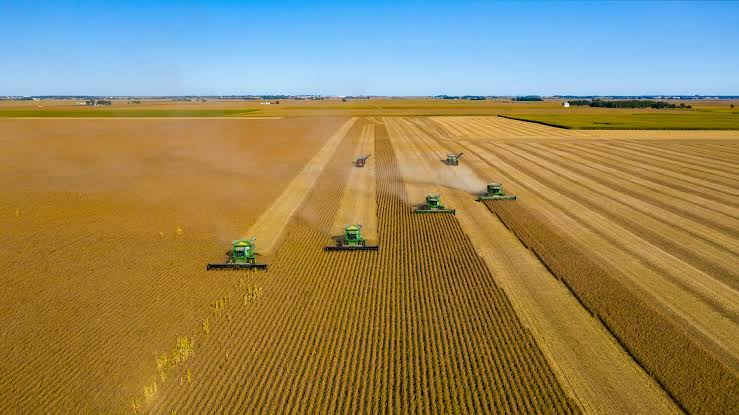There are no items in your cart
Add More
Add More
| Item Details | Price | ||
|---|---|---|---|
Intensives agriculture creates many challenges for both human & environment and has become a major contributor to the climate crisis. 
2nd October 2024
Did you know that 4.84 billion hectares of habitable land are used for agriculture? This accounts for a staggering 45% of all habitable land on Earth. Most of this is dedicated to intensive agriculture, a method focused on maximizing crop yield and livestock production through modern techniques like mechanization and automation.
With a global population of over 8 billion people—and a projected increase of 30% by 2050—the demand for food will also surge. The FAO estimates that our current annual food production of 8.5 billion tonnes will need to rise to 13.5 billion tonnes by 2050. While intensive farming may seem like the most efficient solution to feed the world, it brings severe environmental and societal consequences.
Let’s dive into the impacts of intensive agriculture and explore some sustainable solutions to these pressing problems.
Soil is crucial to farming, yet intensive agriculture is one of the biggest contributors to soil degradation. Two practices—mono-cropping and excessive use of synthetic fertilizers—are the main culprits.
In mono-cropping, the same crop is planted over large areas, depleting the soil of specific nutrients. For example, crops like corn absorb high levels of nitrogen, potassium, and phosphorus, which disrupt the natural nutrient balance. To replenish these, farmers often use synthetic fertilizers. Though cheaper, synthetic fertilizers strip the soil of biodiversity and deplete Soil Organic Carbon (SOC), reducing fertility over time.
For instance, in Karnataka, India, low levels of SOC are already affecting more than half of the state’s farmland. This is alarming given that Karnataka is one of the top five states in fertilizer consumption. Increasing chemical use is not yielding long-term benefits. If unchecked, this could become an environmental and socio-economic disaster for the state, and a cautionary tale for other regions.
Water pollution
Chemical runoff from intensive farming contaminates water bodies, contributing to water pollution. Excess nutrients like nitrogen and phosphorus find their way into rivers and oceans, creating massive dead zones.

Visual representation of how dead zones are created
Take the Mississippi River in the U.S., for instance. As one of the most polluted rivers, it carries excess nutrients from farms upstream to the Gulf of Mexico, causing harmful algal blooms. These blooms create oxygen-depleted "dead zones" where aquatic life can no longer survive. The scale of destruction is enormous stretching over 5,000 kilometers of coastal waters.

Intensive agriculture is also a significant contributor to air pollution. In regions like India’s Ganga River basin, farmers often burn crop residue after harvesting to quickly clear their fields. This practice, known as stubble burning, releases enormous amounts of pollutants into the air, particularly PM 2.5, which is hazardous to human health.
In India, PM 2.5 levels reach as high as 193 to 270 micrograms/cubic meter during crop-burning seasons, while the Central Pollution board India recommends a maximum of 60 micrograms/cubic meter. Agriculture-related air pollution is responsible for between 44,000 and 98,000 premature deaths annually in India.

Stats showing premature deaths
In addition to air pollution, deforestation driven by agricultural expansion has devastating effects on biodiversity and the climate. It is estimated that 2,400 trees are cut down every minute for agricultural use, contributing to habitat loss and accelerating climate change.
Despite these daunting challenges, there are sustainable farming solutions that can mitigate the negative impacts of intensive agriculture. These solutions include controlled environment farming (such as hydroponics and indoor vertical farming) and traditional practices like permaculture and Poly cropping).
Controlled environment farming offers numerous benefits:
While this method is promising, it has limitations. For example, staple crops like wheat and corn cannot currently be grown efficiently in controlled environments. The infrastructure is also costly, making it less accessible to small farmers.
On the other hand, traditional farming practices like permaculture and Poly cropping are more cost-effective and environmentally friendly. These methods promote soil health, reduce the need for synthetic inputs, and help farmers become self-sufficient, reducing their reliance on debt.

Permaculture farm overview
In permaculture, farmers grow diverse crops in small spaces, creating self-sustaining ecosystems. Practices like rotational grazing and Poly cropping naturally replenish soil nutrients, extending the land's fertility without leaving fields fallow. These systems not only benefit the environment but also improve economic outcomes for small-scale farmers.
While intensive agriculture may have helped us meet the food demands of a growing population, its environmental and social costs are becoming too high to ignore. It’s crucial that we shift to more sustainable farming methods that benefit both people and the planet. Whether through controlled environment farming or the revival of traditional agricultural practices, solutions exist that can reverse the damage caused by intensive farming.
If you're interested in exploring these solutions in greater detail, subscribe to our channel for more in-depth content on sustainable agriculture. Let’s work together to build a future where farming doesn’t just feed us, but also heals the planet.
If you want to explore more about intensive agriculture, visit our YouTube channel and don’t forget to subscribe!
Click here
Mansi
Co-founder at Sustenable